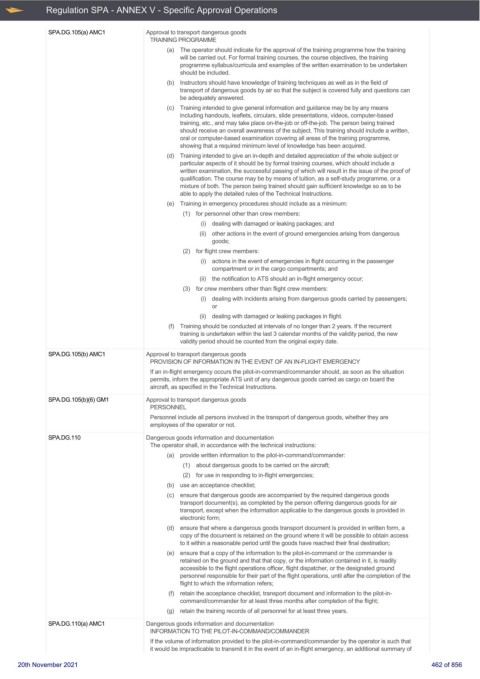Page 462 - UK Air Operations Regulations 201121
P. 462
~
~ Regulation SPA - ANNEX V - Specific Approval Operations Centrik
SPA.DG.105(a) AMC1 Approval to transport dangerous goods
TRAINING PROGRAMME
(a) The operator should indicate for the approval of the training programme how the training
will be carried out. For formal training courses, the course objectives, the training
programme syllabus/curricula and examples of the written examination to be undertaken
should be included.
(b) Instructors should have knowledge of training techniques as well as in the field of
transport of dangerous goods by air so that the subject is covered fully and questions can
be adequately answered.
(c) Training intended to give general information and guidance may be by any means
including handouts, leaflets, circulars, slide presentations, videos, computer-based
training, etc., and may take place on-the-job or off-the-job. The person being trained
should receive an overall awareness of the subject. This training should include a written,
oral or computer-based examination covering all areas of the training programme,
showing that a required minimum level of knowledge has been acquired.
(d) Training intended to give an in-depth and detailed appreciation of the whole subject or
particular aspects of it should be by formal training courses, which should include a
written examination, the successful passing of which will result in the issue of the proof of
qualification. The course may be by means of tuition, as a self-study programme, or a
mixture of both. The person being trained should gain sufficient knowledge so as to be
able to apply the detailed rules of the Technical Instructions.
(e) Training in emergency procedures should include as a minimum:
(1) for personnel other than crew members:
(i) dealing with damaged or leaking packages; and
(ii) other actions in the event of ground emergencies arising from dangerous
goods;
(2) for flight crew members:
(i) actions in the event of emergencies in flight occurring in the passenger
compartment or in the cargo compartments; and
(ii) the notification to ATS should an in-flight emergency occur;
(3) for crew members other than flight crew members:
(i) dealing with incidents arising from dangerous goods carried by passengers;
or
(ii) dealing with damaged or leaking packages in flight.
(f) Training should be conducted at intervals of no longer than 2 years. If the recurrent
training is undertaken within the last 3 calendar months of the validity period, the new
validity period should be counted from the original expiry date.
SPA.DG.105(b) AMC1 Approval to transport dangerous goods
PROVISION OF INFORMATION IN THE EVENT OF AN IN-FLIGHT EMERGENCY
If an in-flight emergency occurs the pilot-in-command/commander should, as soon as the situation
permits, inform the appropriate ATS unit of any dangerous goods carried as cargo on board the
aircraft, as specified in the Technical Instructions.
SPA.DG.105(b)(6) GM1 Approval to transport dangerous goods
PERSONNEL
Personnel include all persons involved in the transport of dangerous goods, whether they are
employees of the operator or not.
SPA.DG.110 Dangerous goods information and documentation
The operator shall, in accordance with the technical instructions:
(a) provide written information to the pilot-in-command/commander:
(1) about dangerous goods to be carried on the aircraft;
(2) for use in responding to in-flight emergencies;
(b) use an acceptance checklist;
(c) ensure that dangerous goods are accompanied by the required dangerous goods
transport document(s), as completed by the person offering dangerous goods for air
transport, except when the information applicable to the dangerous goods is provided in
electronic form;
(d) ensure that where a dangerous goods transport document is provided in written form, a
copy of the document is retained on the ground where it will be possible to obtain access
to it within a reasonable period until the goods have reached their final destination;
(e) ensure that a copy of the information to the pilot-in-command or the commander is
retained on the ground and that that copy, or the information contained in it, is readily
accessible to the flight operations officer, flight dispatcher, or the designated ground
personnel responsible for their part of the flight operations, until after the completion of the
flight to which the information refers;
(f) retain the acceptance checklist, transport document and information to the pilot-in-
command/commander for at least three months after completion of the flight;
(g) retain the training records of all personnel for at least three years.
SPA.DG.110(a) AMC1 Dangerous goods information and documentation
INFORMATION TO THE PILOT-IN-COMMAND/COMMANDER
If the volume of information provided to the pilot-in-command/commander by the operator is such that
it would be impracticable to transmit it in the event of an in-flight emergency, an additional summary of
20th November 2021 462 of 856

